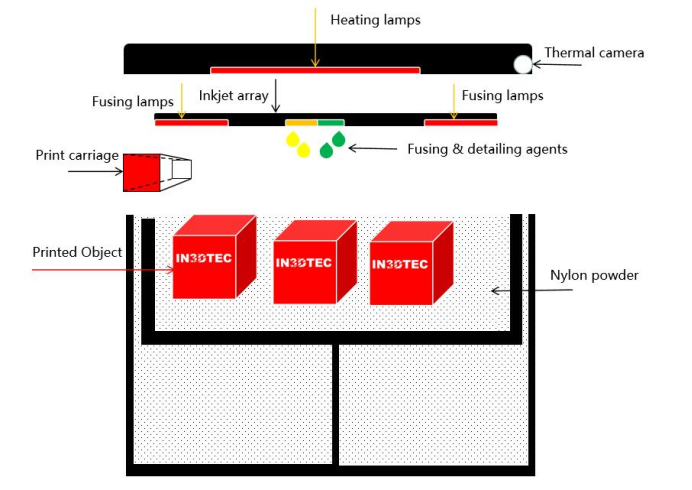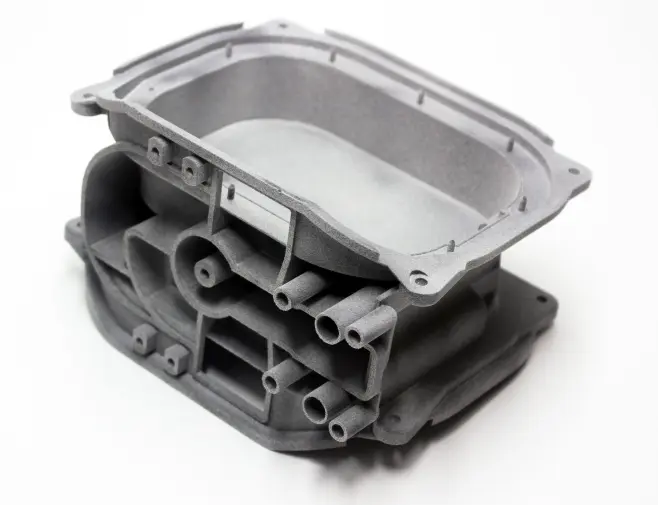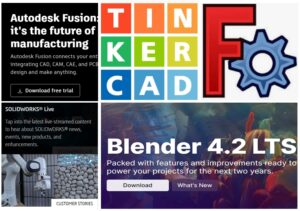White paper of HP Multi Jet Fusion
How does HP Multi Jet Fusion work?
Introduction
HP Multi Jet Fusion (MJF) technology is a powder-bed fusion 3D printing technology that allows for the production of accurate, functional prototypes and final parts, including color parts. In addition, HP MJF is a technology that does not require support structures, thus enabling the design of complex geometries without additional costs, which would be expensive or not even possible to produce with traditional manufacturing processes.
HP MJF 3D printing process
The HP MJF 3D printing process begins with a thin layer of uniformly pre-heated polymer powder particles that is spread across the build platform.
Then, to achieve part quality at a high speed and produce truly functional parts, HP MJF technology uses the HP multi-agent printing process. HP’s in-depth knowledge of 2D printing solutions and the capability of HP’s proprietary architecture makes it possible to
print millions of drops per second along each inch of the bed width, thus enabling extreme precision and dimensional accuracy.
HP Multi Jet Fusion’s multi-agent printing process can control the exact amount of each agent that is deposited in each voxel of the intended part. This printing process involves two different types of agents that are applied across the build platform: fusing agents
and detailing agents.
A fusing agent is applied where the particles are meant to fuse together in the powder in order to create the corresponding part cross section, leaving the rest of the powder unaltered. A detailing agent is applied to the edges of the part in order to modify the
fusing process and create fine detail and smooth surfaces.
Next, an energy source passes over the build platform, provoking a reaction between the agents and the material that causes the material to selectively fuse to form a complete layer, thus resulting in production throughput, material density similar to common Injection Molded plastics, and consistent mechanical properties in all directions.
The process is then repeated until a completely functional part has been formed.
The 3D printing process using HP MJF is summarized in the following figure:


Post processing for HP Multi Jet Fusion Technology
MJF is a new technology that delivers certain advantages over legacy print processes, but there are still post-processing steps that are required before items can be considered finished. Worth noting, however, is that the HP Jet Fusion 3D Processing Station has the option of “Fast Cooling,” which allows prints to be cooled down more quickly so that they may be removed for more immediate processing. In addition, the latest HP Jet Fusion 5200 3D Printing Solutions include a Natural Cooling Unit designed for economical continuous printing.
Within the processing station for the Jet Fusion 4200 and 5200 systems, there is a vacuum used to remove powder. Once removed from the processing station, bead blasting, airblasting or waterblasting is performed to clear any remaining powder, not unlike SLS.
Bead Blasting: This process consists of shooting an abrasive media, usually a bead (size and type results in different surface finishes), at high pressure at a printed part with compressed air, knocking loose unfused powder while also smoothing the finish of the part. This can be done manually or automatically, with manual bead blasting relying on a foot pedal-driven system for propelling the beads as opposed to an automated tumbler, turntable or conveyer. Manual may be preferred for fragile parts.
Water Jet Blasting: This process features the jetting of water and air onto a part to remove powder and can include the use of a blast media for preliminary surface finishing. Typically more expensive than bead blasting, this process is ideal for complex geometries and cavities automatically while also reducing surface roughness without the need for additional post processing (such as a vibratory system). No dust is produced, as well.
Airblasting: Air blasting is necessary after bead blasting, but not water jetting, and some bead blasting machines have air blasting capabilities. After bead blasting, air blasting must be used to remove the remaining powder from the surface of the printed part using a closed cabin air pressure machine with a minimum air pressure of three bar.
Secondary Post-Processing
After the necessary post-processing steps described above, parts may need further finishing to bring the part up to technical requirements. This includes methods for reducing surface roughness, as well as methods for changing the color or finish of the part, like dying, electroplating and painting.
Sanding: Post-processing techniques can range from manual to almost entirely automated. For example, a company may want to smooth their Multi Jet Fusion parts; this could be done with manual sanding, though it would take a long time and be cost-prohibitive. However, it may work for one-off objects or visual prototypes.
Vibratory Tumbling: “Vibratory tumbling is another method that can be used to smooth Multi Jet Fusion parts that is hands-off and largely automated,” she added. “Though it can take several hours, because the process does not require supervision and can process many parts at once it is very cost-effective. You can buy vibratory tumblers of different sizes, according to your particular specifications such as quantity and part size.”
Vibratory finishing can be performed as a wet or dry process. In wet vibratory tumbling, ceramic and plastic media are used and create a more polished finish, with less wear on the part, but produces waste from the liquid-abrasive media. The dry process is cleaner and wastes less, but may be more aggressive.
Chemical polishing: This process uses a chemical to smooth the surface of printed parts without impacting its mechanical properties, resulting in a controllable level of glossiness from matt to gloss to shiny.
Dying: In addition, not unlike other processes, MJF parts can be subject to any number of finishes. Though there is an MJF line dedicated to full-color 3D printing (HP Jet Fusion 580/380 series), these systems are currently designed for smaller batches. When coloring parts that haven’t been printed on those machines, dying can be performed, either manually in pots of hot water or using automated dying equipment.
Dyeing is the most common secondary post-processing technique of MJF users and may be best for parts that are visible or subject to wear, as the color penetrates the surface of the part. Dying white parts, rather than grey, offers a greater range of dying options. Manual dying, which usually involves leaving the part in an 80-100°C dye bath for about eight minutes, is comparatively inexpensive. Automated dying machines, however, may be more efficient, as they use specific programs for mixing the dye bath, as well as conditioning, dyeing, part rinsing, dye disposal, and cleaning.

|
|
|
|
|
|
|
|
|
|
|
|
|
|
|
|






















